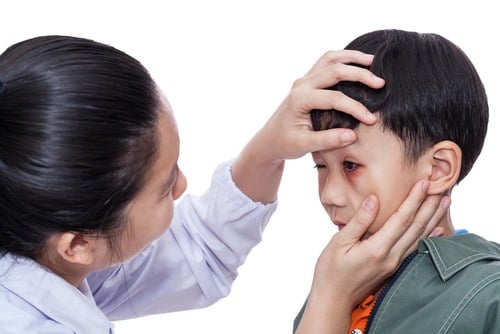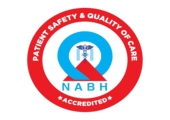A chemical burn in the eye can be a serious and potentially sight-threatening injury. If you believe you have suffered a chemical burn in your eye, it is essential to seek immediate medical attention from a qualified healthcare professional. In the meantime, here are some general steps you can take to provide first aid for a chemical burn in the eye:
- Rinse the eye with water: Immediately flush the eye with clean, lukewarm water for at least 15 minutes. Use a gentle, steady stream of water to rinse the eye, holding the eyelids open to ensure thorough irrigation. If possible, use a clean, portable eyewash station or an eyewash bottle to flush the eye. Avoid using hot or cold water, as extreme temperatures can further damage the eye.
- Remove contact lenses: If you are wearing contact lenses, remove them as soon as possible. Contacts can trap chemicals against the surface of the eye, exacerbating the injury.
- Do not rub the eye: It may be instinctive to rub the eye when it is injured, but this can further irritate the eye and potentially damage the cornea. Avoid rubbing or touching the eye with your hands or any other objects.
- Protect the unaffected eye: If only one eye is affected, be cautious to protect the unaffected eye from any potential contamination. You can use a clean, dry cloth or a sterile eye patch to cover the natural eye.
- Seek medical attention: Chemical burns to the eye can cause serious damage and require prompt medical attention. Contact a healthcare professional, preferably an ophthalmologist or an emergency room, for immediate evaluation and treatment. Provide information about the type of chemical involved, if known, to help with appropriate treatment.
- Do not use eye drops or medications: Avoid using any eye drops or medications without the guidance of a healthcare professional. Some medications may not be suitable for use in the case of a chemical burn and can potentially worsen the injury.

Chemical Eye Burn symptoms
A chemical eye burn can cause a variety of symptoms, which may vary depending on the severity and type of chemical involved. Common symptoms of a chemical eye burn may include:
- Eye pain: Chemical eye burns can cause severe pain or discomfort in the affected eye. The pain may be described as burning, stinging, or throbbing.
- Redness and inflammation: The eye may appear red and inflamed, with increased blood vessels on the surface of the eye.
- Tearing and watering eye: The eye may produce excessive tears or water as a response to the irritation caused by the chemical.
- Blurred vision: Vision in the affected eye may be blurry or hazy due to the damage caused by the chemical.
- Sensitivity to light: The eye may become more sensitive to light, causing discomfort in bright environments.
- Foreign body sensation: There may be a sensation of having a foreign object or something stuck in the eye due to the presence of the chemical.
- Swelling of the eyelids: The eyelids may become swollen or puffy as a result of the eye’s inflammatory response to the chemical injury.
- Eye discharge: The eye may produce abnormal discharge, such as pus or mucus, as a response to the injury.
Causes of Eye Burn
A chemical burn in the eye can occur when a foreign substance comes into contact with the eye and causes damage to the delicate tissues of the eye, including the cornea, conjunctiva, and other ocular structures. There are many different types of chemicals that can potentially cause a chemical burn in the eye. Some common causes of eye burns include:
- Household cleaning products: Chemicals commonly found in household cleaning products such as bleach, ammonia, and drain cleaners can be highly corrosive and cause serious eye injuries if they come into contact with the eye.
- Industrial chemicals: Chemicals used in various industrial settings, such as acids, alkalis, solvents, and caustic substances, can cause chemical burns in the eye if proper safety precautions are not followed.
- Automotive products: Chemicals used in automotive products, such as battery acid, windshield washer fluid, and antifreeze, can be highly toxic and cause severe eye injuries if they come into contact with the eye.
- Personal care products: Certain personal care products, such as hair dyes, nail polishes, and eyelash adhesives, may contain chemicals that can cause eye irritation or burns if they accidentally come into contact with the eye.
- Agricultural chemicals: Pesticides, herbicides, and fertilizers used in agriculture and gardening can be highly toxic and cause chemical burns in the eye if proper protective measures are not taken.
- Workplace accidents: Chemical burns in the eye can occur in various occupational settings, such as laboratories, manufacturing plants, construction sites, and other workplaces where workers may come into contact with hazardous chemicals.
- Accidental exposure: Accidental exposure to chemicals, such as during a chemical spill or splash, can also cause chemical burns in the eye.
Factors Affecting Healing Time of Chemical Eye Burns
The healing time for a chemical burn in the eye can vary depending on the severity of the injury and the extent of the damage caused by the chemical. Mild chemical burns may heal within a few days to a week, while more severe burns can take several weeks or months to heal completely. In some cases, long-term complications or permanent damage may occur, leading to prolonged healing time or permanent vision impairment.
Factors that can influence the healing time of a chemical burn in the eye may include:
- The severity of the burn
- Type and concentration of the chemical
- Promptness of treatment
- Presence of complications
- Individual healing ability
It is important to follow the recommended treatment plan and follow-up care provided by a qualified healthcare professional for a chemical burn in the eye. Regular monitoring and proper management can help optimize the healing process and minimize the risk of long-term complications.






